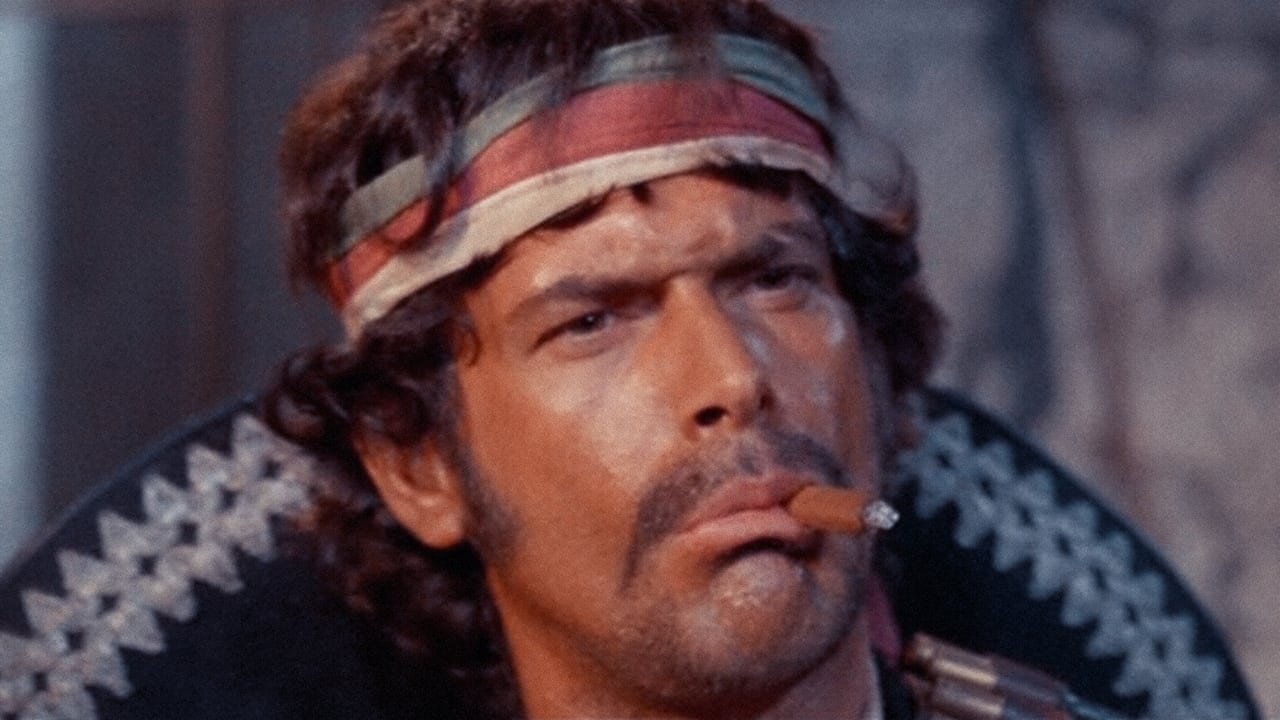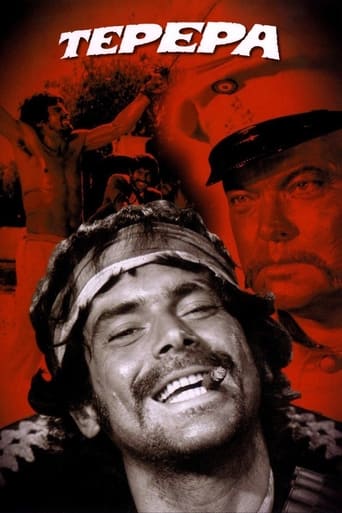VividSimon
Simply Perfect
MoPoshy
Absolutely brilliant
Curapedi
I cannot think of one single thing that I would change about this film. The acting is incomparable, the directing deft, and the writing poignantly brilliant.
Delight
Yes, absolutely, there is fun to be had, as well as many, many things to go boom, all amid an atmospheric urban jungle.
ma-cortes
The movie centers on a Mexican revolutionary nicknamed Tepepa (a likable Tomas Milian) who joins forces an outlaw band during the Mexican revolutionary war by time of the president Madero (played by a Spaghetti usual secondary , Francisco Sanz) . The Mexican guerrilla leader Tepepa wielding his Mauser gun and his gang fight against colonel Cascorro (special appearance of Orson Welles). When illiterate Tepepa is about to be executed , there appears a serious and smooth-talking British doctor named Henry Price (the blond John Steiner) and saves him from a firing squad . Later on , starring duo , Milian-Steiner , undergo a strange relation of friendship and hatred . But someone prepares a relentless vendetta on a surprising final .It's a magnificent western film with dazzling shootouts between the protagonists and the contenders . This film belongs to the numerous group that are set during the Mexican revolution , called ¨Zapata Western sub-genre¨ , like are the Italian ones : ¨ Duck you sucker¨ ,¨Compañeros¨ , ¨The mercenary ¨ and the Americans : ¨The wild bunch and ¨The professionals¨. ¨Tepepa¨ results to be the swan-song of this sub-genre . The picture blends violence , western action , plot twists and shoot'em up with high body-count . ¨Tepepa¨ is fast movement and that's why it is entertaining ; besides , there is thoughtful dialog with an intelligent writing by Franco Solinas , an author of communist ideology who wrote political screenplays such classics as ¨The battle of Argel¨ and ¨I'm the Revolution¨ , the latter bears remarkable resemblance on some issues to ¨Tepepa¨ . The Cuban Tomas Milian , as usual , puts faces , grimaces , crying and overacting , but he plays splendidly in a similar character to ¨Cuchillo¨ from the trilogy directed by Sergio Sollima . Tomas created his own image and propelled himself to stardom in likewise fashion with such important Spaghetti movies as The Bounty Killer (1966) , The Big Gundown (1967) with Lee Van Cleef , Face to Face (1967) , Django Kill! (1967) and Run, Man, Run (1968). Enjoyable score by the great maestro composer Ennio Morricone who composed lots of Spaghetti Western scores , it contains a sensitive musical leitmotif . There are many fine technicians and nice assistants as the splendid cameraman Francisco Marin who makes an atmospheric photography , including barren outdoors , dirty landscapes under a glimmer sun , being shot , of course , on location in Almeria , Spain . However , being necessary and perfect remastering because of the original copy is worn-out . The motion picture was well directed by Giulio Petroni who filmed another classic Italian western as ¨Death rides a horse¨ , though also shot other inferior but acceptable Spaghettis as ¨Night of serpent¨ and ¨A sky full of stars for a roof¨. Rating : Above average S.W. , worthwhile seeing .
zardoz-13
The American version of "Death Rides A Horse" director Guilio Petroni's "Tepepa" qualifies as utterly egregious. Something is missing because everything seems truncated, and the European cut runs about twenty minutes longer. Mind you, this realistic but adventurous Italian Spaghetti western about the Mexican revolution resembles later westerns, such as Sergio Corbucci's "The Mercenary," Sergio Corbucci's "Companeros," Damiano Damiani's "A Bullet for the General," and Sergio Leone's "Duck, You Sucker." Unfortunately, watching the VHS copy is like looking through a keyhole at life because this was filmed in Techniscope at 2.35.1 so each shot looks spectacular. During the letterboxed opening credits sequence, the visual compositions of "The Texican" lenser Francisco Marín are breathtaking, endowing this mangled Spaghetti with great look. Nevertheless, despite its being mutilated, "Tepepa" looks like it might be a good movie. The peasant army ambush of the Mexican Army is nothing short of brilliant. Orson Welles makes a genuinely menacing villain who is proved better off dead than alive. Not surprisingly, Tomas Milian of "The Big Gundown" makes a charismatic as well as introspective revolutionary leader. We watch the bandit change during the trajectory of the action. The English doctor is the ultimate villain because he never wavers from his vow to kill the Milian revolutionary figure. The theme that recurs through the Franco Silanos screenplay is revenge. Interestingly, Silanos wrote both "The Mercenary" and "A Bullet for the General" so this is familiar turf for him. Everybody seems like they are after revenge, from the outsider British doctor who renounces his oath as a doctor to kill an enemy to the messiah but flawed bandit Tepepa who resumes the revolution when he sees how the Army controls the president. Petroni and Solinas dwell on the injustices wrought by the revolution in the on-going clash of the haves and the have-nots. The ending and the unsavory quality of the British doctor and the Mexican revolutionary may alienate some audiences. This is not a cheerful, but rather a serious Spaghetti western about the disillusion that came with the end of the revolution and the realization that hundreds of good men had died to put a good man into the presidency who was later manipulated by the evil men.Although it ostensibly resembles a western, this Spaghetti belongs to the Mexican Revolution subgenre of political Italian westerns. The third act when Tepepa and his revolutionaries ambush the Mexican Army is is model of economy and violence. Petroni develops tension and suspense in this scene and stages the ambush with flair, right down to explosives soaring into our faces. Moreover, however, are the levels of sophisication that flow within the contours of this terrific scene. As the Army approaches the pass, everybody grows tense and suspicious. Suddenly, everything seem tranquil now because the army column has relaxed itself. The Mexican Colonel thinks about this aloud as relief sweeps over the column when several women driving goats approach from the north. The seasoned officer sees danger where his men now see no danger and he orders them to shoot the women tending the flock. The soldiers shoot them women down, but the goats have had time to infiltrate the column and they are wearing sticks of dynamite. BOOM!Ennio Morricone is a musical sensation. Since he worked with Sergio Leone on "Fistful of Dollars," he created the signature musical sound of the Spaghetti western. The soundtracks that he produced often enhanced an inferior western. The distinctive sound of Morricone is something that nobody could or should imitate. Don't get me wrong, other outstanding composers, like Gianni Ferroi, Luis Enríquez Bacalov, Riz Ortolani, Angelo Francesco Lavagnino, Nico Fidenco, Francesco De Masi and Benedetto Ghiglia, thrived during the Spaghetti western years. The Ennio Morricone orchestral soundtrack is above the maestro's towering standards. The piano rift and the marching music is memorable.
MARIO GAUCI
Perhaps the Spaghetti Western genre's last word on the Mexican Revolution (around which so many fine examples are centred) - barring, of course, Leone's marvelous DUCK, YOU SUCKER (1971) - from one of Italian cinema's foremost political writers, Franco Solinas. Tomas Milian is at his best here (with which he appears to concur himself, as per quotes found in the actor's biography included on the DVD!); his ambiguous character is mainly revealed through the film's intermittent flashback structure (borrowed from Sergio Leone).Like Petroni's own DEATH RIDES A HORSE (1968), the film sees the title character being constantly 'shadowed' by someone for unspecified reasons and, like Sergio Sollima's FACE TO FACE (1967), we are presented with a clash of two personalities (and two worlds) - in this case, larger-than-life Mexican revolutionary Milian and quietly-spoken British doctor John Steiner - that could turn violent at any moment...although the confrontation between Milian and an influential Army Colonel - surprisingly underplayed by Orson Welles (but, then, his presence can only add to the film's stature) - is, at least, as important and central to the plot; indeed, their long-awaited showdown is quite splendid (even if the plot still has a couple more twists up its sleeve!). Needless to say, Ennio Morricone's stirring and unforgettable score is one of the film's trump cards (and, in fact, the SE from Italy's Alan Young Pictures I own includes the soundtrack - running approx. 26 minutes - on a second disc!) and includes a beautiful ballad sung by Christy (which, alas, is only heard in its complete form on the CD!); another crucial asset, of course, is the film's beautiful Techniscope photography.Even so, powerful and moving though it is, the film ends up being tiresomely long if wholly engrossing: the print on offer here is vaunted as being the complete 136-minute version which has been virtually unseen since the film's original release; actually, it only lasts for 127 minutes in PAL mode, which would bring it to about 133 minutes in full...but, then, a deleted scene has been included as an extra on the DVD (albeit without sound, though accompanied by the director's comments: the dialogue couldn't even be re-recorded for completeness' sake because Petroni himself has no idea what is being said and admitted that, once a film is finished, he throws away the script!) and that's 3 minutes in length, which would account for that discrepancy! As a matter of fact, when I first watched the film (recorded off late-night Italian TV), it ran for a mere 97 minutes...though, since it's been a while, I can't discern any of the new footage - Petroni does remark, however, that the cuts effected Morricone's compositions quite severely; as for myself, I recall being underwhelmed by that preliminary experience! Among the extensive bonus features are offered a number of mostly complimentary reviews from the time of its original release and publicity shots with the stars and director, where the film was still being advertised under its working title of VIVA LA REVOLUCION! The Audio Commentary, however, turns out to be a disappointment: advertised as being full-length, it only runs for 73 minutes (jumping to relevant scenes but, even then, there are a few gaps which sometimes run for several minutes at a stretch!); still, even if Petroni seems to be hazy about many details, his comments - urged by a moderator - make for an interesting listen nonetheless. Apparently, Solinas clashed with the director over the ending (which he didn't write and consequently hated) with the face of the deceased Tepepa superimposed on a shot of the revolutionaries riding off into the sunset (led by the young kid who plays an important part in the film, particularly in relation to the John Steiner character and who utters the great final line; weirdly enough, the child actor himself grew up to be a mafioso!). Ironically, too, Welles' involvement seems to have worked against the film because, like one of his own projects, it's been butchered and released over the years in various forms! This has resulted in TEPEPA being largely neglected in discussions of the more significant Spaghetti Westerns; with this 'new' version, where its essential quality is more than evident, it's definitely ripe for reappraisal...
John Seal
The American video release of Tepepa does the film no favours. Apparently suffering drastic cuts (40 minutes!) from its continental version, the film now makes little sense. Additionally, the pan and scan print seriously compromises the original 2.35:1 aspect ratio. Whether the original film was any good is a matter of conjecture: though John Steiner is excellent as a British doctor, Orson Welles mumbles his way through his performance as a Mexican colonel and Ennio Morricone's score is cribbed from his earlier work. Nevertheless, a DVD restoration seems absolutely necessary--we can't pass judgment on this film until we see it at full length and in widescreen.

